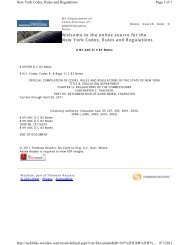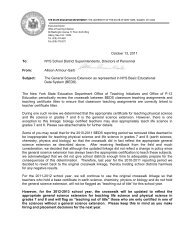ESL Learning Standards - Higher Ed - New York State Education ...
ESL Learning Standards - Higher Ed - New York State Education ...
ESL Learning Standards - Higher Ed - New York State Education ...
You also want an ePaper? Increase the reach of your titles
YUMPU automatically turns print PDFs into web optimized ePapers that Google loves.
Advanced<br />
Students complete Intermediate task. When students are<br />
familiar with the genre, pairs of students read additional<br />
fables/legends, and present summaries to the class. The<br />
class guesses the lessons/morals taught. In culminating<br />
activity, class creates a fable or legend, round-robin style.<br />
Performance indicators: 1, 2, 3, 4, 5, 6, 7, 8, 9<br />
English Proficiency Level<br />
Transitional<br />
Students complete Advanced task. Class brainstorms elements<br />
of the genre and creates a checklist. Teacher selects<br />
one or two lessons/morals, and each student writes an<br />
original fable or legend in keeping with the genre. Students<br />
use the checklist to evaluate the writing. Students may use<br />
illustrative computer software (e.g., Storybook Weaver CD-<br />
ROM) to create their final draft. They share with class.<br />
Performance indicators: 1, 2, 3, 4, 5, 6, 7, 8, 9, 10, 11, 12<br />
Students complete Intermediate task. In small groups, students<br />
select a story they know and convert it to a puppet<br />
show, adding original text if desired. Students make simple<br />
puppets and scenery, rehearse, and present the show. They<br />
evaluate the performances, using the checklist.<br />
Performance indicators: 1, 2, 5, 6, 9, 10, 11<br />
Students complete Intermediate task. Students brainstorm<br />
possible scenarios for original puppet shows. In small<br />
groups, students write an original script, make puppets and<br />
scenery, rehearse, and present the show. Students may<br />
videotape the performances and evaluate them, using the<br />
checklist.<br />
Performance indicators: 1, 2, 4, 5, 6, 8, 9, 10, 11, 12<br />
Students take a pretest/survey on their understanding of<br />
poetry devices and form (e.g., matching the terms haiku,<br />
cinquain, couplet, rhyme, rhythm, meter, alliteration, onomatopoeia,<br />
personification, metaphor, simile with examples<br />
of those forms). Teacher and students read aloud poems<br />
such as “Keep a Poem in Your Pocket” by Beatrice Schenk<br />
de Regniers and books like Many Luscious Lollipops by<br />
Ruth Heller. Students write poetry and make a book of<br />
poetry definitions, using their own work. Students share<br />
one of their definitions with the class. Students take a<br />
posttest/survey on poetry terms.<br />
Performance indicators: 1, 2, 3, 5, 6, 8, 10<br />
Students complete Advanced task. Students learn and practice<br />
additional ideas for poetry writing (e.g., ideas related to<br />
names or the senses; themes such as “Things I’ve never<br />
seen or done,” “I used to be … but now I am …,” and<br />
“What’s in a…”). Class work is published and read aloud<br />
in class. Students select a poem to recite in front of their<br />
peers, who score their performance with a rubric that<br />
addresses poise, pacing, expression, volume, pronunciation,<br />
and any other category agreed upon by teacher and performers.<br />
Performance indicators: 1, 2, 3, 5, 6, 8, 10, 11<br />
<strong>ESL</strong><br />
2<br />
Elem<br />
CLASSROOM<br />
TASKS<br />
Sample Classroom Tasks 51
















